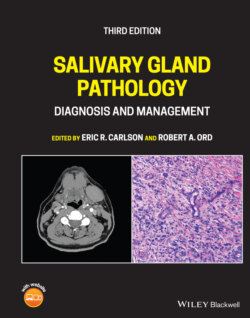Читать книгу Salivary Gland Pathology - Группа авторов - Страница 97
Warthin tumor
ОглавлениеPapillary cystadenoma lymphomatosum, or Warthin tumor, is the second most common benign lesion of the salivary glands. These tumors are typically well marginated but inhomogenous and found in the parotid tail of the superficial lobe and 15% present as bilateral or multicentric disease (Madani and Beale 2006b). There is by CT a heterogenous density and very mild enhancement (Figure 2.63). They typically have small cysts but do not demonstrate calcifications. The differential diagnosis therefore includes lymphoepithelial cysts, primary neoplasms, metastatic disease, and lymphoma. MRI signal on T1 is generally low but may be heterogenous, and T2 is either high signal based on its more cystic features or heterogenous. If the tumor is primarily solid, the imaging characteristics may mimic a PA with relatively homogenous hypoechoic architecture. Contrast with Gd follows CT characteristics. FDG uptake can be high on PET imaging. Warthin tumors contain oncocytes and are thought to be the mechanism by which they tend to accumulate 99mTc‐pertechnetate. The 99mTc‐pertechnetate uptake and retention after lemon juice‐stimulated washout by the normal tissue is a good indicator of the diagnosis of Warthin tumor (Miyaki et al. 2001). This pattern is much less commonly seen by other lesions such as lymphoepithelial cysts, PAs, and oncocytomas. This technique allows visualization of Warthin tumors as small as 9 mm (Miyaki et al. 2001). By its peripheral location and cystic components, it can be mistaken for a necrotic lymph node or second branchial cleft cyst (Ikeda et al. 2004). The tail of the parotid region can be difficult to differentiate from adjacent cervical lymphadenopathy. However, coronal images can aid in determining the site of origin. If the lesion is medial to the parotid tail, it is more likely cervical jugular chain lymphadenopathy and if it is more laterally located, it is more likely an exophytic tumor from the parotid gland (Hamilton et al. 2003).
Figure 2.63. Axial contrast‐enhanced CT of a heterogenous parotid mass at the tail of the gland, with multiplicity and cystic or necrotic changes, diagnosed as a Warthin tumor (arrow).
